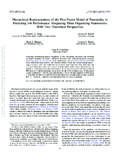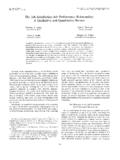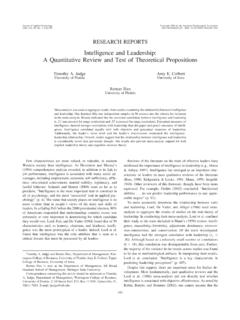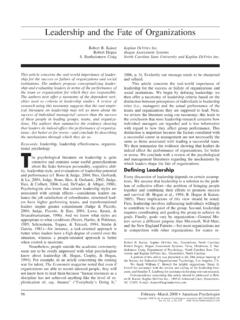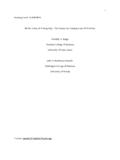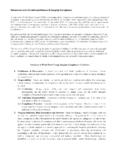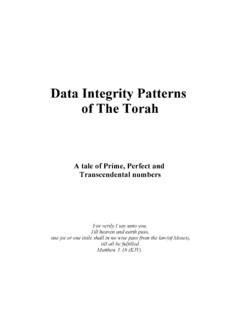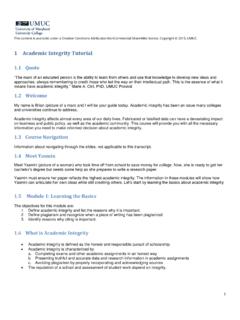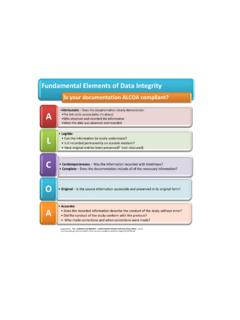Transcription of The bright and dark sides of leader traits: A review and ...
1 The bright and dark sides of leader traits: A review and theoretical extensionof the leader trait paradigmTimothy A. Judgea, , Ronald F. Piccolob, Tomek KosalkacaUniversity of Florida, United StatesbRollins College, United StatescUniversity of Central Florida, United Statesarticle infoabstractThe leader trait perspective is perhaps the most venerable intellectual tradition in leadershipresearch. Despite its early prominence in leadership research, it quickly fell out of favor amongleadership ,despite recentempirical support fortheperspective, conceptualworkinthe area lags behind other theoretical perspectives. Accordingly, the present review attempts toplace the leader trait perspective in the context of supporting intellectual traditions, includingevolutionary psychology and behavioral genetics.
2 We present a conceptual model that considersthe source of leader traits, mediators and moderators of their effects on leader emergence andleadership effectiveness, and distinguish between perceived and actual leadership consider both the positive and negative effects of specific bright side personality traits: theBig Five traits, core self-evaluations, intelligence, and charisma. We also consider the positive andnegative effects of dark side leader traits: Narcissism, hubris, dominance, and Machiavellianism. 2009 Elsevier Inc. All rights :LeadershipPersonalityLeader traitIf one sought tofind singular conditions that existed across species, one mightfind few universals.
3 One universal that doesexist, at least those species that have brains and nervous systems, is leadership. From insects to reptiles to mammals, leadershipexists as surely as collective activity exists. There is the queen bee, and there is the alpha male. Though the centrality of leadershipmay vary by species (it seems more important to mammals than, say, to avians and reptiles), it is fair to surmise that wheneverthere is social activity, a social structure develops, and one (perhaps the) defining characteristic of that structure is the emergenceof a leader or leaders . The universality of leadership, however, does not deny the importance of individual differences indeed theemergence of leadership itself is proof of individual differences.
4 Moreover, even casual observation of animal (including human)collective behavior shows the existence of a leader . Among a herd of 100 cattle or a pride of 20 lions, one is able to detect aleadership structure (especially at times of eating, mating, and attack). One quickly wonders: What has caused this leadershipstructure to emerge? Why has one animal (the alpha) emerged to lead the collective? And how does this leadership cause thiscollective toflourish or founder?Given these questions, it is of no surprise that the earliest conceptions of leadership focused on individual differences. The mostfamous of these is Thomas Carlyle's great man theory, which argued, For, as I take it, Universal History, the history of what man hasaccomplished in this world, is at bottom the History of the Great Men who have worked here (Carlyle, 1840/2008, ).
5 Despiteitsintuitive and presumably historical appeal, until recently, this great man (or woman) approach, and the trait perspective in general,fell on hard times. Reviewers of the literature commented that the approach was too simplistic (Conger & Kanungo, 1998, p. 38), futile (House & Aditya, 1997, p. 410), and even dangerous and a product of self-delusion (seeAndersen, 2006, p. 1083).1 The Leadership Quarterly 20 (2009) 855 875 Corresponding Kosalka).1 House and Aditya (1997)themselves did not espouse this viewpoint. Rather, they were summarizing what they perceived to be the prevailing sentiment in theleadership $ see front matter 2009 Elsevier Inc.
6 All rights lists available atScienceDirectThe Leadership Quarterlyjournal homepage: so often happens in intellectual affairs, however, as the obituaries were being written, the seeds of a reemergence werebeing sown. Personality theory, for many years fragmented by issues both pragmatic (how to measure personality) andphilosophical (whether to focus on individual differences [nomothetics] or individual development [idiographics]), began tocoalesce, at least to some degree, around a typology that provided both an organizing structure and a reasonable measurementapproach. This structure called thefive-factor model or the Big Five has been related to virtually all applied criteria ( ,Barrick& Mount, 1991).
7 Independently, meta-analyses of a diverse set of topics caused re-examination of many previously heldassumptions in general, these meta-analyses showed that subjective eyeballing of data across studies generally leads reviewersto overestimate the variability in the data, and underestimate central tendencies. The intersection of these trends meta-analysesusing thefive-factor model as an organizing framework has produced powerful insights into many if not most organizationalbehavior (seeR. Hogan, 2005; Ones, Dilchert, Viswesvaran, & Judge, 2007).The leadership literature is no exception. In the most comprehensive meta-analysis to date,Judge, Bono, Ilies, and Gerhardt(2002)analyzed 222 correlations from 73 samples.
8 They found that four of the Big Five traits had non-trivial correlations withleadership emergence and effectiveness: extraversion, conscientiousness, emotional stability, and openness to , thefive traits had a multiple correlation ofR=.53 with leader emergence andR=.39 with leadership effectiveness. Thegains revealed by the quantitative review notwithstanding, critics of the trait approach , some remain unimpressed by the size of the validity coefficients. In comparing the personality literature to an oft-cited,earlier review (Guion & Gottier, 1965),Murphy and Dzieweczynski (2005, p. 345)concluded, One major concern was that thevalidity of personality inventories as predictors of job performance and other organizationally relevant criteria seemed generallylow.
9 An examination of the current literature suggests that this concern is still a legitimate one. Andersen (2006, p. 1088)concluded: The main point is that the relationship (measured as correlation) is low. Consequently, personality has lowexplanatory and predictive power. Morgeson et al. (2007)went even further, arguing, among other things, that multiplecorrelations (between an entire Big Five typology and a criterion) are inappropriate, and that personality validities remain so pooras to cast doubt on their utility for , somewhat related, criticism of particular relevance to leadership is that while personality may reveal whether anindividual is perceived as leader -like, personality is less than successful in identifying whether those leaders are successful in anobjective , Hogan, and Craig (2008)criticized theJudge, Bono et al.
10 (2002) and Judge, Erez, Bono, & Thoresen, (2002)study for this (failed) distinction, noting, that the study focuses on how leaders are regarded and tells us little about leadingeffective teams or how such traits help organizations prosper (p. 102).Morgeson et al. (2007)also criticize theJudge, Bonoet al. (2002) and Judge, Erez et al. (2002)meta-analysis on these grounds, arguing, Perceived influence is not equivalent toeffectiveness, and showing that there is a correlation of a personality dimension with perceived influence does not provide astrong basis for use of this measure to select managers who will be effective (p.)
